CHAPTER IX - Sedge Meadow
Just by crossing the right of way and moving through a few yards of
woods, we enter a landscape unlike any other in the park. This is
the
sedge meadow. The first thing one notices, other than the stillness,
is
the total lack of any brushy undergrowth--there's a carpet and a
canopy, but not much else. In very early spring, the sedge meadow
can
be rather gray...
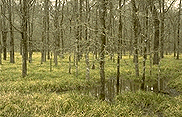
But by late spring, it's a lush place full of dappled sunlight
and
shifting shadows.
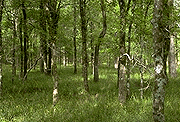
Sedge meadows form in bottomland floodplains of fairly sizable
creeks. The periodic flooding keeps woody undergrowth to a
minimum.
This meadow is in the floodplain of Lick Creek. It's moist all
year and
downright squishy during rainy seasons.
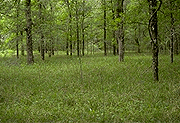
The meadow is criss-crossed by dozens of water channels and small
oxbow "lakes." These represent parts of the former paths of Lick
Creek
and its tributaries. In the dry season, they are mostly empty and
paved
with fallen leaves.
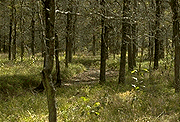
During the wet season, all of the meanders and oxbows hold water.
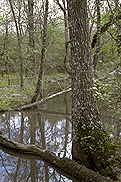
A few of the larger oxbows at the bottom of the sedge meadow hold
water year round.
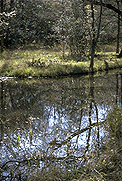
This is a good place to find duckweed, watermeal, knotweed,
aquatic
grasses...and snakes.
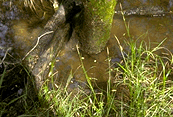
Due to the wetland nature of the sedge meadow, we have acquired
a new
set of canopy plants. The oaks are a bottomland variety of Post
Oak.
Winged Elm is replaced in lowland areas by this tree, Cedar Elm
or Ulmus
crassifolia, which prefers wetter conditions.

Cedar elm has very rough, round-tipped leaves in contrast to the
smooth, pointed leaves of Winged Elm. This elm flowers and fruits
in
the fall, making it even easier to tell the two apart.
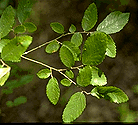
Most of the carpet here is made up of Cherokee Sedge, Carex
cherokeensis. This is about as close to a monostand as you
will
find in nature. Separate male and female flowers are borne in
nodding
"spikelets." Most owners of sedge meadow land ruin it in a short
time
by overgrazing. Sedges don't have the nutritional content of
grasses
nor do they recover from grazing as well as grasses. This is one
of the
nicest sedge meadows in the Brazos Valley. The severe
drought in 2010 and 2011 meant the loss of many trees in the
park. The sedge meadow was hit particularly hard. It
will be interesting to see the effects the increased sunlight
reaching the ground. Will the sedge meadow become
drier? Will different species flourish?
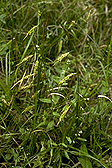
There are a few grasses mixed with the sedges. Inland Sea Oats,
Chasmanthium
latifolium, has graceful arching panicles of wide, flat
spikelets.
We also find Canadian Wildrye and Autumn Bluegrass (which blooms
in the
spring.)
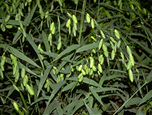
One of the most interesting plants in the sedge meadow is White
Crown-beard or Frost-
weed (Verbesina virginica.) The plant is not much to look
at,
and the flowers are sort of a dirty white. If, however, a sudden
sharp
freeze follows warmer weather, the plant shows how it gets its
name.
The sap freezes and ruptures the stem. It seeps out and freezes
as it
does, hardening into thin, fragile, transparent wings of ice
that swirl
around the plant. There is a lot of Frost-weed here, and when
this
happens, it looks as if the whole meadow has been swathed in
cobweb or
angel-hair. This rare sight is well worth a frigid hike.

Another resident of the sedge meadow is a summer-blooming
thistle, Cirsium
engelmannii, which looks somewhat like the spring blooming
Cirsium
texanum. Some of the plants are upwards of six feet tall.

There are also some interesting vines here. Trumpet Creeper, Campsis
radicans, climbs to great heights in some of the trees.
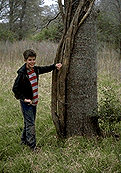
The stems can grow to rival the trunks they grow on. It's a very
aggressive plant that frequently escapes control in home landscape
settings.

Here is a small Trumpet Creeper at the start of its career,
hanging
on with dozens of aerial rootlets.
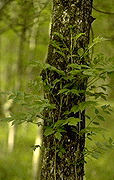
The flowers are bright orange-red and trumpet shaped. Sadly, most
of
the blooms are high in the canopy; often all one sees is fallen
corollas at the base of some tree.

Hummingbirds just love these flowers.

Something else readily found in the sedge meadow is Green Ash, Fraxinus
pennsylvanica. The seedlings are easy to spot; the adults
are sort
of nondescript.

You can leave the sedge meadow in a slightly different direction
and
come out on the road to the creek. On the sandy roadside can be
found
Eryngo or Button Snakeroot (Eryngium yuccifolium). This
is a
member of the carrot family, but as the name implies, its leaves
look
like yucca leaves.
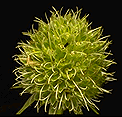
Chapter 10 - Porcupine Eggs
Lick Creek Park Field Trip Home Page